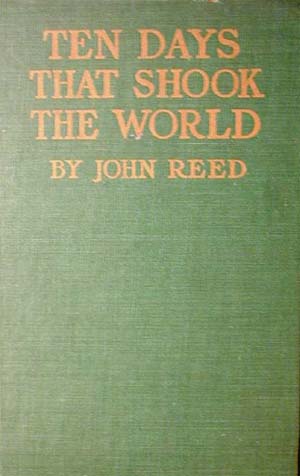Book Review
This is the 95th Anniversary of the Bolshevik-led Russian Revolution. It is fitting that I review a book that did much to give Westerners a bird's-eye view of what happened during that tumultuous year. Forward To New Octobers!
Ten Days That Shook The World, John Reed, New American Library Edition, New York, 1967
I, on more than one occasion, have mentioned that for a detailed history of the ebb and flow of the Russian Revolution of 1917 from February to October of that year your man is the great Russian revolutionary Leon Trotsky. Trotsky’s History of the Russian Revolution is partisan history at its best. One does not and should not, at least in this day in age, ask historians to be ‘objective’. One simply asks that the historian present his or her narrative and analysis and get out of the way. Trotsky meets that criterion. I have also mentioned in that same context that there are other excellent sources on this subject, depending on your needs. If you are looking for a general history of the revolution or want an analysis of what the revolution meant for the fate of various nations after World War I or its effect on world geopolitics look elsewhere. E.H. Carr’s History of the Bolshevik Revolution offers an excellent multi-volume set that tells that story through the 1920’s. Or if you want to know what the various parliamentary leaders, both bourgeois and Soviet, were thinking and doing from a moderately leftist viewpoint read Sukhanov’s Notes on the Russian Revolution (hard to find these days). If you need a more journalistic account for the period of the seizure of power by the Bolsheviks and the immediate aftermath, the book under review, John Reed’s classic Ten Days That Shook the World is invaluable.
If we do not, as mentioned above, expect our historians to be ‘objective’ then we should have a lesser expectation of those journalists who write the ‘first draft of history.’ Reed made no bones about the fact that that he was a partisan of the Bolshevik-led social revolution that he was witnessing (and a partisan of the heroic actions under extremely trying conditions of the city working- class, the uprooted peasantry, and the peasant soldier who formed the core of the Russian army saving some of his most eloquent language for their struggles, successes or failures). He, nevertheless, tells his story reasonably well for those who are not partisans but eager to understand the play between the various political, class and military forces.
Moreover Reed seemed to have been everywhere in Petersburg (and for a lesser time in Moscow and at the military fronts) during those days, those crucial first of November 1917 days (our calendar) when the axis of world politics shifted for a time and affected those politics for most of the rest of the 20th century. One minute he was in some Cadet tea party (bourgeois liberals) where they were more afraid of the Soviets and what that meant that the Germans at the door, and acted on that traitorous conviction , the next minute at the mad house Smolny (seat of the various Soviet enclaves), the next day at the ever changing military front (with it ever changing loyalties, first to the bourgeois Provisional government, then neutral, then pro-Soviet and every possible combination depending on the political situation, who had the most to offer, or what agitator from what party just spoke well enough to win a following).
He is as likely to have been reporting from Petersburg’s Winter Palace, the seat of the Kerensky's Provisional Government, as Smolny, the seat of the insurgent Soviets. We can find him among the bourgeois politicians of the City Duma or at the Russian Army General Staff headquarters. Hell, he was also in Moscow when things were hot there as the Soviet forces tried to seize the Kremlin. He is at meetings large-Peasant Soviet size- or in some back room at Smolny with Trotsky’s Military Revolutionary Committee that directed the uprising. To that extent, as a freelancer on the move, he covers physically during this period much more territory than Trotsky could as central director of the action and thus has more first- hand observations to convey.
Reed’s style tends toward straight forward reportage with little obvious sense of irony in the various situations that he is witnessing. Of course, against Trotsky’s masterly ironic sense he is bound to suffer by comparison. Nevertheless Reed gets us into places like the City Duma and into the heads of various characters like the Mayor of Petersburg that Trotsky, frankly, displayed no interest in dealing with. Probably the greatest compliment that one could pay Reed is that he is widely quoted as a reliable source in many historical accounts from Trotsky on the winning side to someone like Kerensky on the losing side. For those who want a quick but serious overview of the dynamic of the October Revolution then here is your man. Add in his companion Louise Bryant’s separate account, Six Month In Red Russia (if you can find it), and some very good primary source poster, pamphlet and newspaper material in the appendices of Reed’s book and you are on your way.

No comments:
Post a Comment